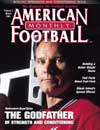AMERICAN FOOTBALL MONTHLY THE #1 RESOURCE FOR FOOTBALL COACHES
Article CategoriesAFM Magazine
|
Out With The Old and In With The NewDesigning a weight room is not an exercise for those who are weak, uninformed or easily impressed.by: Jane Musgrave © More from this issue While the towering Payne Whitney Gymnasium at Yale University is known as the "cathedral of sports," for Steve Plisk and his strength and conditioning staff, it was an ungodly mess. Stuffed in a former wrestling room, the 3,600-square-foot weight room had long outlived its usefulness. "Athletes would show up at their assigned time and have to wait 10 minutes for it to clear out," says Plisk, describing one of the many obstacles he faced trying to run a strength and conditioning program out of the antiquated facility. But three years ago, the university embarked on a program to bring the nearly 70-year-old gym, revered for housing more sports under roof that any building in the world, out of the 1930s and into the 21st century. Last year, as part of a $100 million renovation program, the new Brooks-Dwyer Varsity Strengt....The full article can only be seen by subscribers.
|
|
|||||||
| HOME |
MAGAZINE |
SUBSCRIBE | ONLINE COLUMNISTS | COACHING VIDEOS |
Copyright 2025, AmericanFootballMonthly.com
All Rights Reserved





